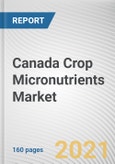Increasing in population and strengthening economy of Canada have fueled the consumption of food. It is crucial to maintain the nutrient level in crops & soil to enhance the productivity and growth of crops. To produce enough food for population in Canada with available cultivable land, farmers are incorporating micronutrients with other essential ingredients for agriculture in the form of fertilizers. Chemical fertilizers that consist of micronutrients protect crops from insects and UV radiations, as well as offer increased yield. Thus, lack of micronutrients can lead to various diseases in plants such as chlorosis, yellowing of leaves, and gummosis, which, in turn, is likely to hamper the quality and yield of plants.
Factors such as increase in need for quality and uniform crop yield due to population expansion and decrease in cultivable land fuel the demand for agricultural micronutrients. In addition, surge in use of micronutrients for various crops such as cereals & grains, fruits & vegetables, pulses, and oilseeds through various application such as fertigation, soil, foliar, and seed treatment is expected to boost plant immunity, thereby driving the growth of the crop micronutrients market in Canada. However, mining of micronutrient reserves and lack of awareness among farmers regarding dosage and proper application of micronutrients are expected to restrain the growth of the crop micronutrients market in Canada. On the contrary, the adoption of new methods of farming for improving productivity is anticipated to offer lucrative opportunities for micronutrient fortified products.
The report on the Canada crop micronutrients market is segmented into form, product type, crop type, and application. Depending on form, the crop micronutrients market is bifurcated into chelated and non-chelated micronutrients. According to product type, it is segregated into boron, copper, iron, manganese, molybdenum, zinc, calcium, magnesium, and others. On the basis of crop type, it is classified into cereals & grains, fruits & vegetables, pulses & oilseeds, and others. By application, it is fragmented into fertigation, soil, foliar, seed treatment, and others.
Top market players in the Canada crop micronutrients market include Agriculture Solutions, Inc., Akzo Nobel N.V., BASF SE, Compass Minerals International Inc., Concentric Ag, Nutrien Ltd., Omex Agriculture, Inc., the Mosaic Company, Univar Solutions Inc., and Yara International ASA.
Key Benefits for Stakeholders
- This report provides a quantitative analysis of the market segments
, current trends, estimations, and dynamics of the Canada crop micronutrients market analysis from 2019 to 2027 to identify the prevailing market opportunities.- The market research is offered along with information related to key drivers, restraints, and Canada crop micronutrients market opportunities.
- Porter’s five forces analysis highlights the potency of buyers and suppliers to enable stakeholders make profit-oriented business decisions and strengthen their supplier–buyer network.
- In-depth analysis of the Canada crop micronutrients market segmentation assists to determine the prevailing market opportunities.
- Market player positioning facilitates benchmarking and provides a clear understanding of the present position of the Canada crop micronutrients market players.
KEY MARKET SEGMENTS
By Form
- Chelated
- Non-chelated
By Product Type
- Boron
- Copper
- Iron
- Manganese
- Molybdenum
- Zinc
- Calcium
- Magnesium
- Others
By Crop Type
- Cereals & Grains
- Fruits & Vegetables
- Pulses & Oilseed
- Others
By Application
- Fertigation
- Soil
- Foliar
- Seed Treatment
- Others
Table of Contents
Methodology
The analyst offers exhaustive research and analysis based on a wide variety of factual inputs, which largely include interviews with industry participants, reliable statistics, and regional intelligence. The in-house industry experts play an instrumental role in designing analytic tools and models, tailored to the requirements of a particular industry segment. The primary research efforts include reaching out participants through mail, tele-conversations, referrals, professional networks, and face-to-face interactions.
They are also in professional corporate relations with various companies that allow them greater flexibility for reaching out to industry participants and commentators for interviews and discussions.
They also refer to a broad array of industry sources for their secondary research, which typically include; however, not limited to:
- Company SEC filings, annual reports, company websites, broker & financial reports, and investor presentations for competitive scenario and shape of the industry
- Scientific and technical writings for product information and related preemptions
- Regional government and statistical databases for macro analysis
- Authentic news articles and other related releases for market evaluation
- Internal and external proprietary databases, key market indicators, and relevant press releases for market estimates and forecast
Furthermore, the accuracy of the data will be analyzed and validated by conducting additional primaries with various industry experts and KOLs. They also provide robust post-sales support to clients.

LOADING...








